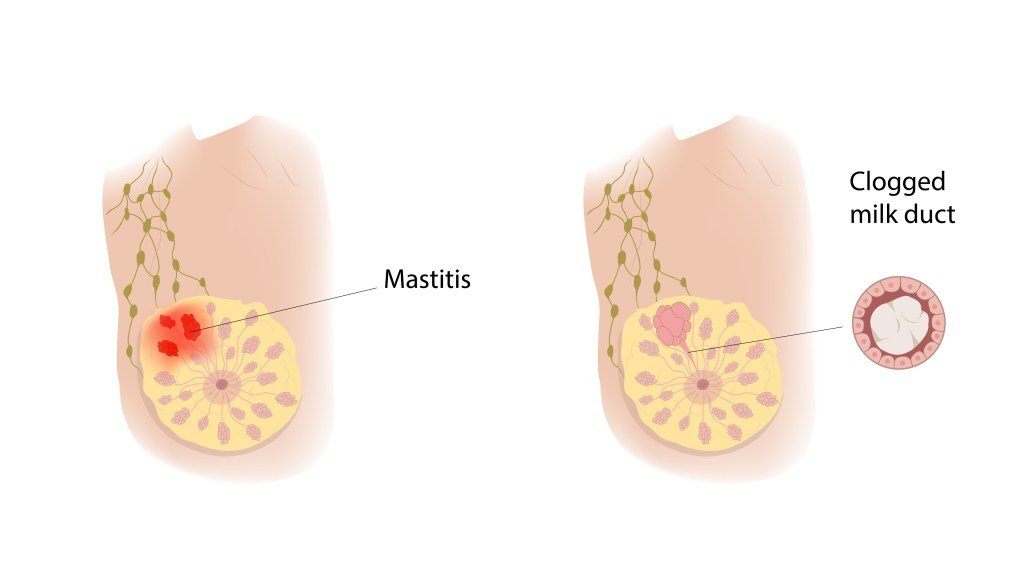Last Updated on July 31, 2023 by Jada Glover
Clogged milk ducts are an inevitable part of the breastfeeding journey for 1 in 5 breastfeeding moms. Once they pop up, there’s one thing new and veteran breastfeeding moms want to know – will they eventually dry up?
If you want to know the same, this is the article for you. We’ll address that in detail in this article. We’ll also share some helpful information about home remedies to try if you have a plugged milk duct, when to reach out to a lactation consultant or healthcare professional, the causes and complications of clogged milk ducts, and more.
Please note that this article contains affiliate links, which means that I may earn a commission if you buy something (at no additional cost to you). Read my full disclosure here. I only recommend products I use and love and recommend to my clients.
What is a Clogged Milk Duct?
A clogged milk duct, also known as a plugged duct or blocked milk duct, is a lump caused by a lack of proper milk flow through a duct in the breast. It can be situated anywhere from the nipple to deep in the ductal system.
Clogged milk ducts are caused by not removing enough milk from the breast at a time (or breastfeeding or pumping too few times per day). When the milk sits in the duct, instead of being expressed, the new milk has nowhere to go, so the duct becomes clogged. The surrounding breast tissue also becomes irritated.
Some of the most common causes of clogged milk ducts include:
- A poor latch at the breast, causing improper drainage.
- Nursing a baby with a preference for one breast over the other. The less used breast is at higher risk of developing a clogged milk duct.
- Skipping pumping or breastfeeding sessions.
- Stopping pumping cold turkey
In addition to the above causes, here are a few risk factors known to precede clogged milk ducts:
- Cracked nipples.
- Not getting enough vitamins and minerals in your diet.
- Uncontrolled stress.
- Failing to get proper rest.
What Does a Clogged Milk Duct Feel Like?
Clogged milk ducts aren’t hard to diagnose – the clogged area is usually hard, red, warm, and painful. And by painful, we mean enough to wince in pain if you touch it. In addition to the painful lump in the affected breast, you could also experience flu-like symptoms, like pain in your muscles or feeling more tired than usual.
Will a Clogged Milk Duct Eventually Dry Up?
Now that you understand the basics of clogged milk ducts, it’s time to answer the main question you have – will a clogged milk duct eventually dry up?
The answer is yes. The good news is that even if you don’t treat the clogged milk duct, it will likely dry up and unclog itself within 24-48 hours.
What’s more, is that having a clogged milk duct won’t usually result in a low milk supply. But the causes associated with these lumps could lead to reduced milk production. So, it’s wise to figure out what’s causing the issue and fix it.
How Can I Unclog a Clogged Milk Duct?
Though clogged milk ducts don’t usually stick around for long, if you have one and are experiencing pain from it, we’re sure you want to get rid of it right away. Thankfully, there are things you can do to get the milk flowing in very little time.
Use Warm Compresses
A tried and true way to get rid of a blocked duct is to do frequent warm compresses. The best way to do so may vary from person to person. However, many find relief with a warm washcloth.
You’ll run the washcloth under some warm water and place it on the affected area for a few minutes a few times per day. Some like to use hot water for their compresses, and you can, but it’s a good idea to test the temperature of the water before placing it on your breast.
If you’d rather pass on the warm compresses, use a heating pad or take a warm bath, submerging your breasts in the water.
Use Gentle Massage
Gentle massage is another great way to get rid of blocked ducts. Though it may be difficult to touch the engorged area of the breast if you can take it, try massaging to loosen the milk duct blockage. With your hands, massage the hard lump with as much pressure as you can take. You don’t have to be rough, but if you don’t use enough pressure, you won’t see results. A few minutes of massaging at a time should be sufficient. Be sure to massage in the direction of your nipple.
Massaging your breast while emptying it will increase your chances of success. So, feel free to get a couple of minutes of massage time in while your baby nurses or during pumping sessions. You can even hand-express some milk while you’re in a hot shower.
This seemed to work the best for me when I experienced clogged ducts. Massaging while the warm water was running down my breast.
Breastfeed or Pump More Frequently
As a Lactation Consultant, breastfeeding and pumping are two of the most effective ways to get rid of clogged milk ducts. As soon as you can, set up your breast pump and empty your entire breast. Pump until all the milk has been removed. And if you’re not pumping, offer the same breast to your baby several times in a row until it’s been fully emptied.
Use a Lactation Massager
If you’ve never heard of a lactation massager, just know that it’s a game changer. It’s a little device that uses heat, vibration, or a combination of both to break up clogged milk ducts. If you’re not having success with the other methods listed above or need a little relief in a pinch, a lactation massager can be helpful.
To use a lactation massager, you’ll turn it on and place it on the clogged milk duct area. You may move the massager around if you’d like (in the direction of your nipple) to encourage milk flow.
Note: This isn’t an exhaustive list of remedies for unclogging milk ducts. To learn more, read this article on Clogged Milk Duct Popping & How To Drain Clogged Milk Ducts.
Mastitis: A Complication of Clogged Milk Ducts

Though most plugged ducts will go away in a day or two, some will stick around and progress into a bigger problem – mastitis.
Mastitis is breast inflammation that may signal a breast infection, and it sometimes follows clogged milk ducts. Some of the most common symptoms of mastitis include fever, a wedge-shaped breast rash, redness on the affected breast, feeling unwell, breast tenderness or swelling, and a breast lump.
It’s not unusual to develop mastitis when your baby starts to sleep through the night or eats more solid foods and drinks water or other types of milk. It may also become an issue when you transition from exclusive breastfeeding to partial breastfeeding or pumping.
If you think you may be dealing with mastitis, contact a healthcare provider or lactation consultant in your area for a consultation. They may want to talk to you or see you in person to get an idea of your situation.
How to Prevent Clogged Milk Ducts
Being that clogged milk ducts can be difficult to handle and come with risks, it’s best to prevent them in the first place.
To prevent clogged milk ducts, keep the following tips in mind:
Evaluate Your Baby’s Latch
A poor latch can prevent your baby from emptying your breast completely. A few signs of a poor latch include:
- Pain in the breast when baby latches on or sucks.
- Baby detaches and relatches repeatedly.
- Very frequent feedings.
- Baby does not suck continuously for 7 to 10 minutes at the beginning of a feeding.
- You have recurring episodes of blocked ducts or mastitis.
If you suspect that latch issues may be at play, it’s definitely time to seek out help. Contact a healthcare professional or lactation consultant for assistance.
Breastfeed or Pump Regularly
Since clogged milk ducts are caused by stagnant milk, it’s important to keep the milk flowing. Try your best not to miss pumping sessions or feedings. And if you do, try to empty your breasts at the next opportune time.
If you have stopped pumping or breastfeeding cold turkey, know that this can increase your risk of developing clogged milk ducts and mastitis. Read this article to learn how to stop pumping cold turkey.
If your baby starts sleeping through the night, keep a manual hand pump or Haakaa pump by your bedside so you can express for comfort and to prevent the backup of milk flow.
Massage While You Breastfeed or Pump
If you have developed clogged milk ducts on several occasions, it pays to be proactive. Massaging your breasts during pumping or nursing sessions can aid in milk flow and prevent your milk ducts from getting backed up. This may not be necessary for everyone, but can certainly make a difference if you want to avoid milk duct clogs.
So, there you have it – milk ducts will eventually dry up. But since they are such a nuisance and could progress to mastitis, it makes sense to take action at the first sign of a clog.
We hope that the information in this article will be helpful to you, and we wish you the best on your breastfeeding journey!



 The 10 Best Probiotics For Nursing Moms (2023)
The 10 Best Probiotics For Nursing Moms (2023)